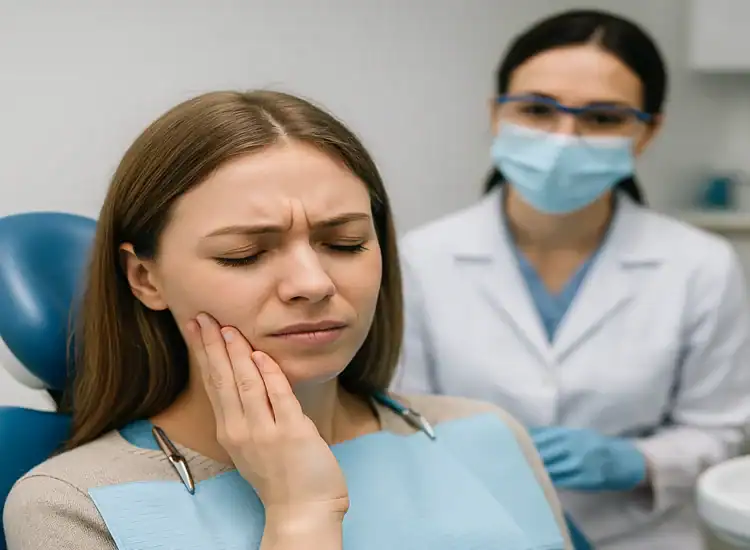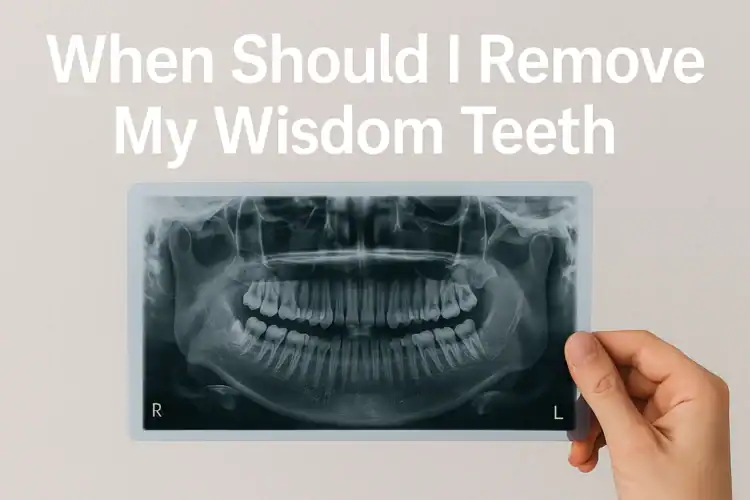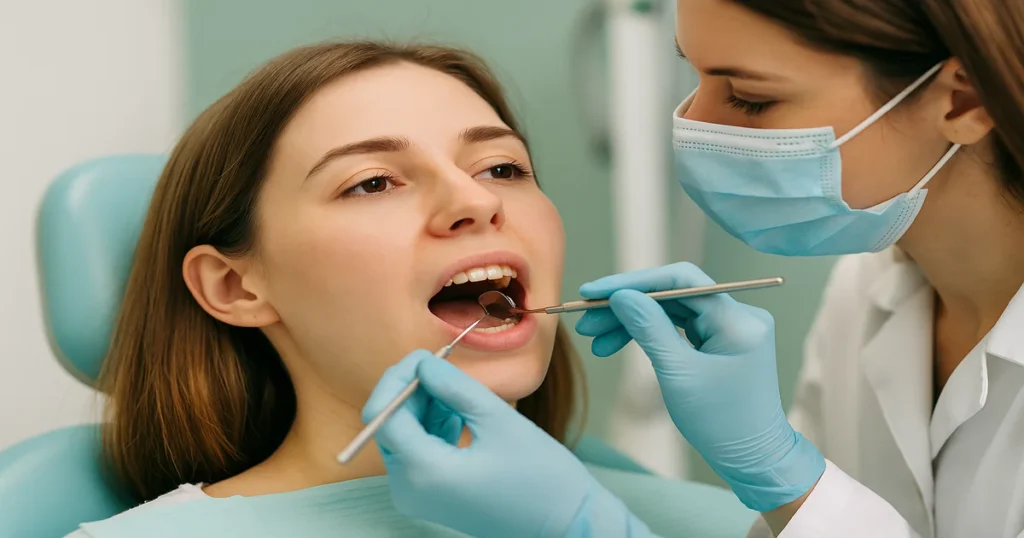Wisdom teeth often emerge between the late teens and early twenties, and not all require removal. However, discomfort, misalignment, or repeated infections can signal that wisdom teeth removal is necessary.
In this article, we’ll cover the key signs that wisdom teeth may need to be removed, the risks of keeping them, what happens during extraction, and tips for post-operative recovery. You’ll gain a comprehensive understanding of how to protect your teeth and maintain oral health.

Signs That Indicate Wisdom Teeth Removal Is Necessary
Wisdom teeth don’t always require extraction, but when they cause pain, misalignment, or recurring infections, removal becomes the best option. Recognizing the early warning signs allows you to act before more serious complications develop. Dentists rely on both symptoms and dental imaging to determine when extraction is necessary, especially in dental check-ups.
Persistent Pain and Discomfort
Ongoing pain in the back of the mouth is one of the most common signals. This discomfort may worsen when chewing or spreading into the jaw and ear. Unlike temporary tooth sensitivity, wisdom tooth pain, or even a normal toothache, tends to persist until the tooth is treated or removed.
Gum Swelling and Redness
Inflamed or swollen gums around a wisdom tooth are often a sign of pericoronitis, an infection that occurs when the tooth partially erupts and leaves an opening for bacteria. Swelling may be accompanied by tenderness, making it difficult to brush or floss the area properly.
Impacted or Misaligned Teeth
When wisdom teeth don’t have enough room to erupt, they can remain impacted or push against neighboring teeth. This pressure can lead to shifting, crowding, or bite misalignment. X-rays are often needed to confirm impaction and guide the treatment plan.
Recurring Infections and Abscesses
Food particles and bacteria trapped around partially erupted wisdom teeth can lead to repeated infections or abscess formation. Patients may notice swelling, pus discharge, or painful episodes that return even after temporary relief.
Bad Breath or Unpleasant Taste
Chronic bad breath or a persistent foul taste in the mouth may indicate bacterial buildup around wisdom teeth. Even with regular oral hygiene, the area is difficult to clean, making these symptoms a red flag for potential extraction.
Early Detection Through Dental Exams
Regular dental checkups and imaging are crucial, as not all wisdom tooth issues cause immediate pain. Dentists can identify impacted or poorly aligned wisdom teeth before they create major problems, giving you the option to plan removal proactively.

Risks of Keeping Your Wisdom Teeth
Keeping wisdom teeth that don’t fit properly in your jaw can lead to more than just occasional discomfort. Over time, they can affect both your oral health and your overall quality of life. Here are the main risks to consider:
- Higher risk of cavities in nearby teeth: Crowded wisdom teeth create tight spaces where food and bacteria can collect. These areas are difficult to reach with a toothbrush or floss, making adjacent molars more vulnerable to decay.
- Gum disease and inflammation: Partially erupted wisdom teeth leave an opening in the gums that becomes a breeding ground for bacteria. This often leads to chronic gum irritation, swelling, and infection, which can progress into more serious periodontal disease.
- Damage to neighboring molars: Misaligned or impacted wisdom teeth can push against the second molars, wearing down enamel and causing tooth sensitivity, pain, or even root damage over time.
- Cyst or tumor formation: In some cases, impacted wisdom teeth develop fluid-filled sacs around them. These cysts can damage the jawbone and surrounding teeth if left untreated.
- Chronic infections and recurring pain: When infections develop repeatedly around wisdom teeth, they not only cause pain and swelling but may also require surgical treatment to resolve.
- Difficulty maintaining oral hygiene: Because wisdom teeth are located far back in the mouth, they are hard to keep clean, especially during busy routines. Following consistent home care and even simple strategies like practicing good oral care habits at work can help, but for many patients, extraction is the only way to fully prevent these issues.
Addressing these risks early with your dentist ensures that small problems don’t turn into bigger ones requiring complex procedures later on, like most dental emergency cases.
What to Expect During Wisdom Teeth Removal Surgery
Understanding the process can help reduce anxiety and prepare you for a smooth recovery. Here are the typical steps involved in wisdom teeth extraction:
1. Anesthesia and Preparation
Before the procedure begins, your dentist or oral surgeon will administer local anesthesia, sedation, or general anesthesia, depending on the complexity of your case. This ensures that you remain comfortable and pain-free throughout the surgery.
2. Accessing the Wisdom Teeth
Once numb, the surgeon makes a small incision in the gum to expose the tooth and surrounding bone. In some cases, a portion of bone may need to be removed to gain proper access.
3. Tooth Removal
The wisdom tooth is carefully loosened and extracted. For impacted teeth, the surgeon may divide the tooth into sections to remove it more easily and minimize trauma to surrounding tissues.
4. Cleaning and Closing the Site
After extraction, the area is thoroughly cleaned to reduce the risk of infection. Stitches may be placed to help the gum tissue heal, and most dissolve naturally within a week.
5. Immediate Recovery
You’ll spend a short time in the dental office as the anesthesia wears off. Swelling, mild bruising, and discomfort are normal during the first few days, and your dentist will provide instructions for pain management, using ice packs, and getting proper rest.

Post-Op Care and Recovery After Wisdom Teeth Removal
Effective post-operative care is critical for preventing complications and promoting healing. Patients should rest with their head elevated, avoid strenuous activity, and follow the recommended diet of soft or lukewarm foods. Gentle oral hygiene, including careful rinsing and brushing, protects the surgical site without disturbing blood clots.
Monitoring for unusual symptoms, such as persistent swelling, severe pain, fever, or the presence of pus, is essential. Early intervention ensures safe recovery and prevents infection. Maintaining follow-up appointments enables your dental team to monitor your healing progress and offer guidance on gradually resuming normal activities. Related tips on tooth extraction care can further support a smooth recovery.
In case of an easier and faster recovery phase, the Mayo Clinic website has said:
“In many instances, taking out wisdom teeth as a young adult — generally 15 to 22 years old — is safer, easier and requires less recovery than taking out wisdom teeth later in life. This is because the roots aren’t fully formed, the bone in the jaws is less dense and recovery from surgery generally is faster.”
Contact Us for Help!
Our experienced team provides expert wisdom teeth removal and personalized post-operative care to ensure a safe, comfortable recovery. Schedule your consultation today to determine if extraction is necessary.
Don’t Delay Treatment if Wisdom Teeth Cause Pain
Wisdom teeth may need removal if they cause pain, misalignment, or increase the risk of infection. Recognizing warning signs early and seeking timely extraction helps protect adjacent teeth and overall oral health. Proper post-operative care ensures recovery is smooth and minimizes complications.
At Tsawwassen Family Dental, our experienced team provides expert wisdom teeth removal and personalized care throughout the process. Schedule a consultation today with the best dentist in Delta to determine whether extraction is necessary and to receive professional guidance for safe recovery.
FAQ
Below are answers to common questions about wisdom teeth removal to help you recognize when extraction is necessary and what to expect during the procedure.
-
What are the signs that I need my wisdom teeth removed?
Pain at the back of your mouth, swelling, infection, or bite misalignment are common signs that extraction may be necessary.
-
Is it always necessary to remove wisdom teeth?
Not all wisdom teeth need removal. If they are properly aligned, healthy, and not causing discomfort, they may not require extraction.
-
What happens if I don’t remove my wisdom teeth?
Untreated problematic wisdom teeth can cause infections, cavities in neighboring teeth, gum disease, or cyst formation.
-
How do I know if my wisdom teeth are impacted?
Dental imaging and professional evaluation can identify impacted teeth that haven’t fully emerged and may be causing pressure or pain.
-
What should I expect during the wisdom teeth removal procedure?
The procedure involves anesthesia, precise extraction, and sometimes stitches. Mild swelling, discomfort, and dietary adjustments are normal during recovery.
Have you had your wisdom teeth removed, or are you considering it?
Share your questions or experiences in the comments below to help others understand the process and recovery.


